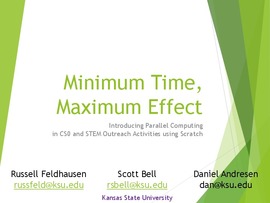| dc.creator | Andresen, Daniel | |
| dc.creator | Feldhausen, Russell | |
| dc.creator | Bell, Scott | |
| dc.date.accessioned | 2015-07-16T19:18:46Z | |
| dc.date.available | 2015-07-16T19:18:46Z | |
| dc.date.issued | 2014-09-24 | |
| dc.identifier.uri | https://hdl.handle.net/11244/15238 | |
| dc.description | Daniel Andresen, Ph.D. is an associate professor of Computing & Information Sciences at Kansas State University and Director of the Institute for Computational Research. His research includes embedded and distributed computing, biomedical systems, and high performance scientific computing. Dr. Andresen coordinates the activities of the K-State research computing cluster, Beocat, and advises the local chapter of the Association for Computing Machinery (ACM). He is a National Science Foundation CAREER award winner, and has been granted research funding from the NSF, the Defense Advanced Research Projects Agency (DARPA), and industry. He is a member of the Association for Computing Machinery, the IEEE Computer Society, the Electronic Frontier Foundation, and the American Society for Engineering Education. | en_US |
| dc.description | Presented at the Oklahoma Supercomputing Symposium 2014, September 23, 2014. | |
| dc.description.abstract | This talk discusses our experiences and outcomes using Scratch to teach parallel computing concepts to students just learning about computer science. We presented versions of this material to middle school and high school girls during a summer camp and then to undergraduate university students enrolled in an introductory computer science course. Using the Scratch development environment, students were able to build, modify and observe the changes in the performance of applications that utilize multi-threaded, concurrent operations. This includes some scenarios that involve more advanced topics, such as race conditions. We first used this exercise in Summer 2013 with a group of middle school girls as part of a summer STEM camp at Kansas State University. After our lesson, 22 of 41 students surveyed showed an interest in a job using high performance computing to solve problems, and 27 of 37 said they were capable of learning to write computer programs. | en_US |
| dc.description.sponsorship | University of Oklahoma
The University of Oklahoma Department of Information Technology
The University of Oklahoma Supercomputing Center for Education and Research
Kansas State University | en_US |
| dc.format.extent | 24 pages | |
| dc.format.extent | 2,089,263 bytes | |
| dc.format.medium | application.pdf | |
| dc.language | en | en_US |
| dc.relation.requires | Adobe Acrobat Reader | |
| dc.subject.lcsh | Computer science -- Study and teaching (Middle school) | en_US |
| dc.subject.lcsh | High performance computing -- Study and teaching (Middle school) | en_US |
| dc.subject.lcsh | Parallel processing (Electronic computers) -- Study and teaching (Middle school) | en_US |
| dc.subject.lcsh | Scratch (Computer program language) | en_US |
| dc.title | Minimum time, maximum effect : introducing parallel computing in CS0 and STEM outreach activities using Scratch | en_US |
| dc.type | Presentation | en_US |
| dc.type | still image | |
| dc.description.peerreview | No | en_US |
| ou.group | Oklahoma Supercomputing::Oklahoma Supercomputing Symposium::2014 | |
| shareok.orcid | 0000-0003-2345-6695 | |
